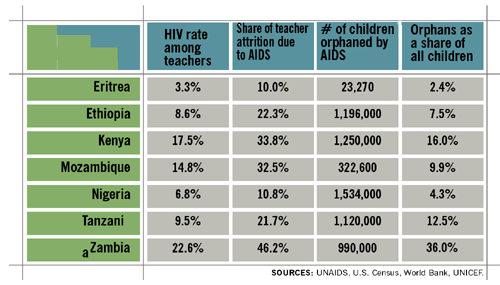CIAO DATE: 09/03
Foreign Policy
A Plague's Bottom Line
Keith Hansen*
In less than a generation, HIV/AIDS has emerged from viral obscurity to become history's worst pandemic, eclipsing even the Black Death, which decimated Europe in the 14th century. The health effects of HIV/AIDS are well documented. But only now, two decades into this global crisis, are the equally staggering economic and social costs finally gaining the attention they demand. In many parts of Africa, HIV/AIDS has crippled development, dimming hopes for progress. The disease is now beginning to ravage Eurasia, and even if it fails to reach the levels it has attained in southern Africa, the economic consequences could still be dire.
The AIDS Explosion
The soaring incidence of HIV in southern Africa
Like many epidemics, HIV follows an “S-curve”—a gradual buildup leading to a rapid surge. Across southern Africa, for example, the percentage of adults living with HIV/AIDS jumped from 2 to 20 in less than six years. Having overrun Africa, the epidemic is now opening new fronts, especially in Eastern Europe and Asia. Registered cases in Russia rose from 11,000 to more than 200,000 in less than four years, and the true number of cases is thought to be well over 700,000 and possibly as high as 1.5 million. Infection rates among pregnant women have surpassed 1 percent in six Indian states so far. In Jakarta, prevalence among intravenous drug users rose from negligible to 50 percent in just three years. Likewise, HIV rates among commercial sex workers in China are soaring and have exceeded 10 percent in one province; there are now signs of rising heterosexual transmission in at least three provinces as well.

The ‘AIDS Tax’
Because AIDS kills people in the prime of their working lives, the disease robs shop floors and government agencies of their most important assets. In the hardest-hit countries, death rates among 20- to 40-year-olds have tripled, devastating workforces in the process. The disease destroys existing human capital, erodes productivity, and raises the costs of doing business. For companies in the worst-affected areas, AIDS can represent a “tax” of between 4 to 12 percent on the wage bill. Some African firms report that their healthcare costs have soared by as much as 500 percent in the past five years.

Mommies, Daddies, and Teachers
When children lose a parent or a teacher, it becomes much harder for those children to reach their potential. Worldwide, millions of children are losing both parents and teachers to AIDS. Nearly 1 million African students a year are deprived of a teacher because of the disease. And, of course, it is not only death that disrupts classrooms; absenteeism among ill instructors and declining morale among their colleagues also undermines learning. Meanwhile, more than 13 million children globally have seen a parent succumb to AIDS. By 2010, the number may reach 25 million. In some African countries, every sixth child is an orphan, a figure without precedent and one that can be attributed largely to AIDS.
Stunted Economies
Over time, adult deaths, declining human capital, and an increasingly frayed social fabric will combine to blunt the productivity growth on which economies depend. Compounding the problem, AIDS will divert resources away from development investment to soaring health and social welfare needs. Likewise, the loss of skilled public servants in all sectors will weaken the ability of governments to manage economies and provide essential services. Current studies on AIDS project that income per head will shrink in hard-hit countries, perhaps dramatically. Recent analyses of South Africa suggest that within a decade, average household income could be 8 percent lower than it is today. Even where HIV rates are more modest, the economic impact may be substantial. using conservative assumptions, a model of AIDS in Russia suggests that the country could lose half a percentage point of gross domestic product (GDP) growth annually starting in 2010, and a full point by 2020. The result would be an economy 10 percent smaller than it otherwise would have been.



Notes
Note *: Keith Hansen manages the World Bank's AIDS campaign team for Africa. Back